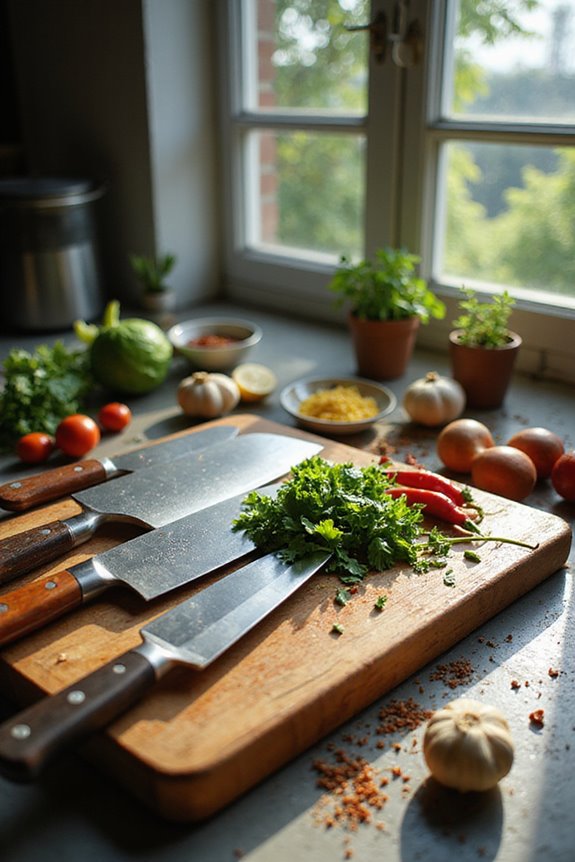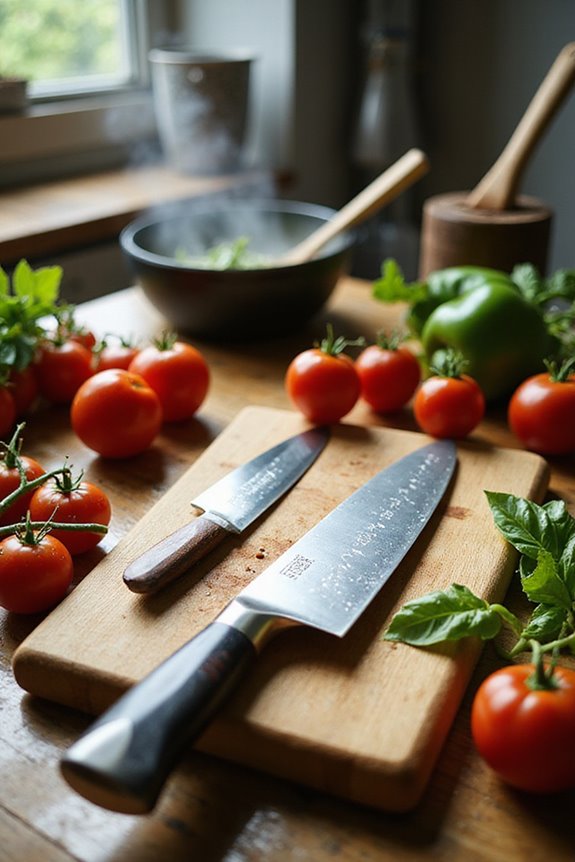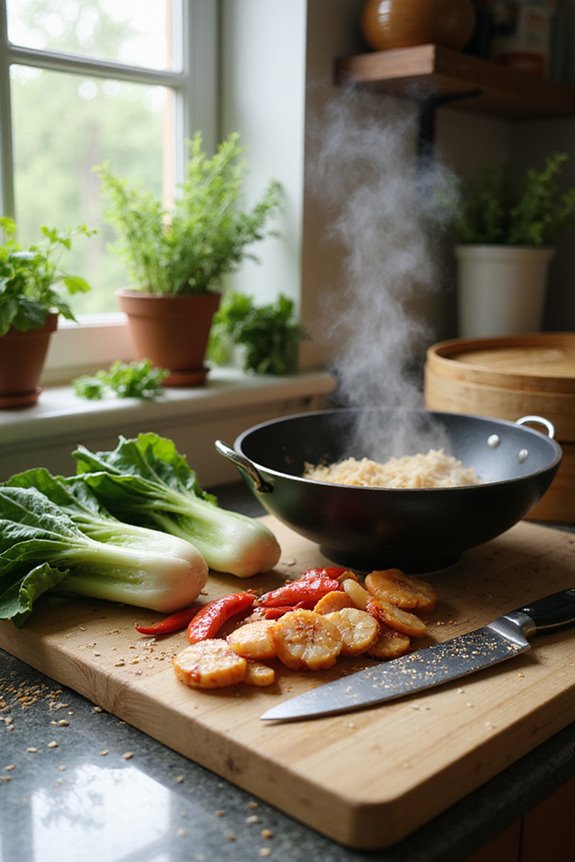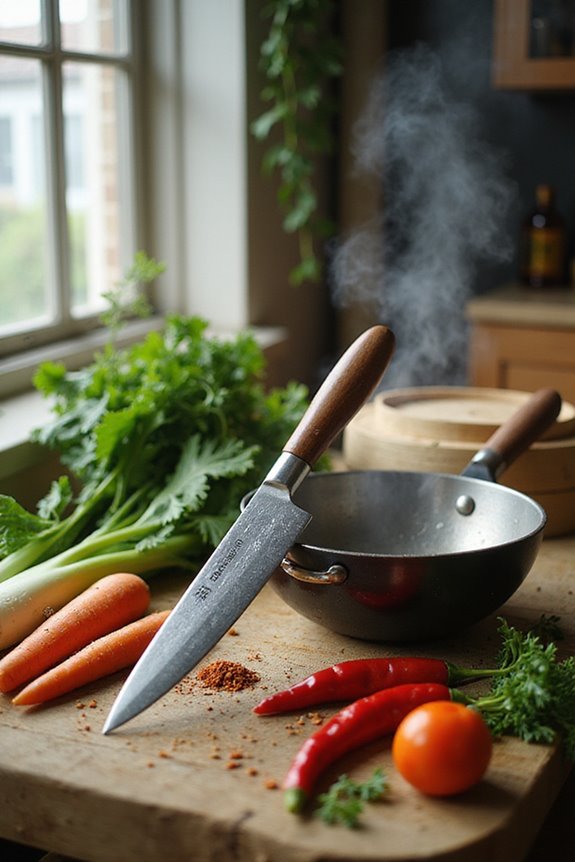As an Amazon Associate, we earn from qualifying purchases. Some links may be affiliate links at no extra cost to you. Although our opinions are based on curated research, we haven't used these products. Articles generated with AI.
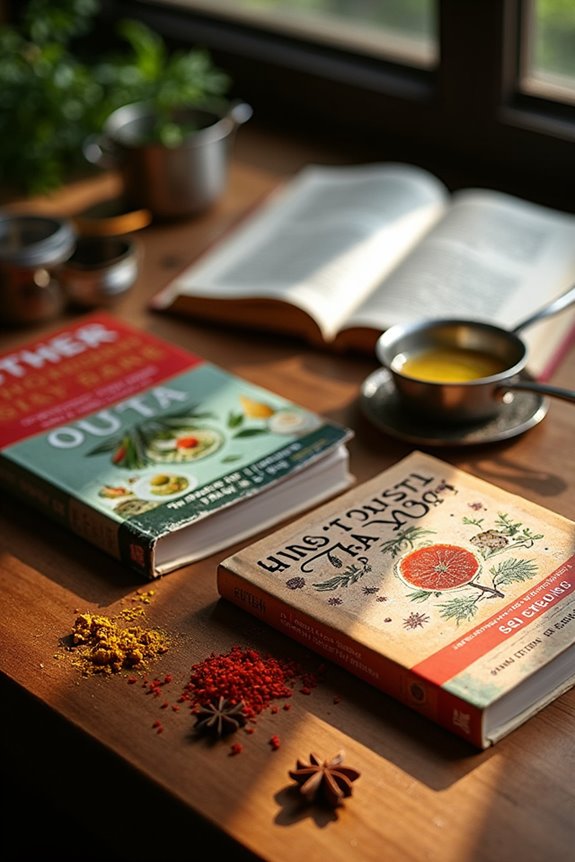
3 Best Singaporean Cookbooks for Mastering Iconic Hawker Dishes at Home
If you want to master iconic hawker dishes at home, check out “Singapore Hawker Classics,” which offers a structured approach to 25 beloved recipes. “Singapore Cooking” showcases fabulous recipes with vibrant photos, while “Agak Agak” provides everyday recipes reflecting Singapore’s street food culture. Each cookbook balances authenticity and accessibility, making them suitable for various skill levels. You’ll uncover delicious flavors and cultural insights as you explore these essential resources for Singaporean cuisine. Keep going for more insights!
Key Takeaways
- Singapore Hawker Classics offers authentic recipes with historical insights, ideal for capturing traditional hawker flavors at home.
- Singapore Cooking showcases stunning visuals and diverse recipes, perfect for adventurous cooks willing to explore intricate dishes, though ingredient availability may be a challenge.
- Agak Agak combines nostalgia with straightforward recipes, ensuring high success rates and adaptability for local ingredients, making it great for everyday cooking.
- Each cookbook emphasizes the importance of ingredient accessibility and authentic cooking techniques to recreate genuine hawker experiences.
- Personal narratives and emotional connections within recipes enhance the cooking journey, deepening appreciation for Singapore’s culinary heritage.
Singapore Hawker Classics: Decoding 25 Favourite Dishes
Singapore Hawker Classics: Decoding 25 Favourite Dishes
- Amazon Kindle Edition
- Temasek Polytechnic (Author)
- English (Publication Language)
If you’re a home cook enthusiastic to explore authentic Singaporean flavors, “Singapore Hawker Classics: Decoding 25 Favourite Dishes” is the perfect cookbook for you. This collection presents traditional hawker recipes with simple explanations, ensuring you can cook confidently. You’ll find well-structured recipes, often with generous portions, accommodating family needs and tastes. Historical notes accompany each dish, enriching your understanding of the cuisine’s background. A glossary at the end helps demystify terms, enhancing your culinary journey. With descriptive notes on flavor and texture, this book appeals to both novice and experienced cooks ready to embrace Singapore’s vibrant culture.
Best For: Home cooks eager to recreate authentic Singaporean hawker dishes with accessible recipes and cultural insights.
Pros:
- Well-structured recipes that accommodate family needs with generous portion sizes.
- Includes historical context for each dish, enhancing the culinary experience and understanding of Singaporean cuisine.
- Comprehensive glossary that helps clarify cooking terms, making it user-friendly for both beginners and experienced cooks.
Cons:
- Some recipes, like laksa, may require adjustments for spice levels, which can be challenging for those unaccustomed to certain flavors.
- Limited to only 25 dishes, which may not cover the full spectrum of Singaporean hawker food.
- May not cater to dietary restrictions, as traditional recipes often include specific ingredients that may not suit everyone’s needs.
Singapore Cooking: Fabulous Recipes from Asias Food Capital
Sale
Singapore Cooking: Fabulous Recipes from Asia's Food Capital
- Tan, Terry (Author)
- English (Publication Language)
- 128 Pages - 03/01/2022 (Publication Date) - Tuttle Publishing (Publisher)
“Singapore Cooking: Fabulous Recipes from Asia’s Food Capital” is an ideal choice for anyone enthusiastic to immerse themselves in the vibrant world of Singaporean cuisine, particularly those longing for authentic hawker flavors. This cookbook showcases stunning photos and straightforward recipes organized into helpful sections like marinades, snacks, and desserts. While some ingredients like fresh galangal might be tricky to find, they encourage you to explore new tastes. The recipes can be intricate, requiring time and patience, yet they offer a rewarding cooking experience. Overall, this book serves as a wonderful gateway to both the flavors and the culinary history of Singapore.
Best For: Anyone eager to explore authentic Singaporean cuisine and recreate beloved hawker flavors at home.
Pros:
- Visually appealing: Beautiful full-page photos enhance the cooking experience and make it more engaging.
- Comprehensive resource: Includes historical context and an ingredient dictionary, making it informative for both beginners and seasoned cooks.
- Varied recipe selection: Offers a wide range of recipes across different categories, catering to diverse tastes and preferences.
Cons:
- Ingredient accessibility: Some recipes require hard-to-find ingredients, which may pose a challenge to cooks not located near Asian grocery stores.
- Complexity of recipes: Many dishes can be intricate and time-consuming, which may deter those looking for quick meal options.
- Variable taste outcomes: Some readers find it difficult to replicate the authentic flavors typically found in Singapore’s hawker stalls.
Agak Agak: Everyday Recipes from Singapore
Sale
Agak Agak: Everyday Recipes from Singapore
- Hardcover Book
- Han Lee, Shu (Author)
- English (Publication Language)
For anyone enthusiastic to explore authentic Singaporean cuisine without the hassle of finding specialty ingredients, “Agak Agak: Everyday Recipes from Singapore” stands out as the perfect choice. This cookbook beautifully captures nostalgic flavors, reflecting the author’s experiences with Singapore’s vibrant street food from 1971. You’ll find a visually stunning layout filled with straightforward recipes that cater to both seasoned cooks and beginners. Readers have reported great success with the dishes, praising the bold flavors that echo classic favorites. With easy adaptations for local ingredients and minimal prep work, this book makes recreating Singaporean cuisine at home enjoyable and accessible.
Best For: Anyone wanting to recreate authentic Singaporean dishes at home with easy-to-follow recipes and readily available ingredients.
Pros:
- Beautifully designed with vibrant photos and a clean layout, making it visually appealing.
- High success rates with recipes, leading to rave reviews from those who enjoy the dishes.
- Adaptable for local ingredients, minimizing the need for hard-to-find specialty items.
Cons:
- Some recipes may have unclear cooking times, which could lead to confusion.
- Limited information on variations for dietary restrictions could be a drawback for some cooks.
- A focus on everyday dishes might not satisfy those looking for gourmet or intricate recipes.
Factors to Consider When Choosing Singaporean Cookbook Hawker Dishes
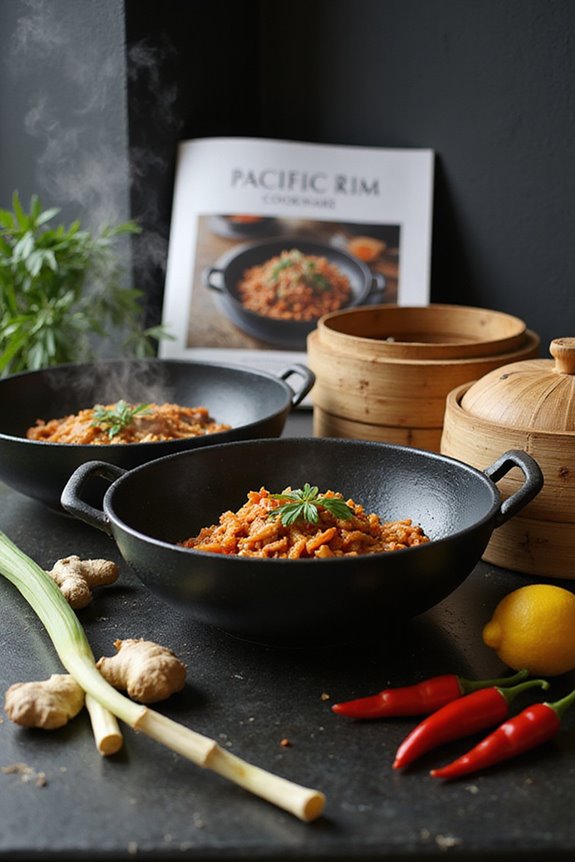
When you’re choosing a Singaporean cookbook for hawker dishes, think about factors like recipe authenticity and ingredient availability. You’ll want to assess the complexity of cooking techniques, especially if you’re a beginner. Additionally, personal experience and the visual appeal of the dishes can really influence which cookbook you ultimately pick.
Recipe Authenticity and Tradition
Choosing a Singaporean cookbook focused on hawker dishes means considering not only the recipes but also the authenticity and tradition that underpin them. Look for cookbooks that provide historical context, helping you understand how each dish came to be and its cultural significance. Authentic recipes should emphasize traditional cooking techniques and ingredients, capturing the essence of generations-old hawker food. Many successful cookbooks strike a balance between preserving old traditions and offering contemporary twists on classic dishes, ensuring a genuine flavor experience. Well-structured recipes guide you through complex processes, reflecting Singapore’s rich culinary heritage. Cookbooks with glossaries or ingredient dictionaries help clarify local terms and ingredients, enhancing your overall cooking experience while staying true to these beloved dishes.
Ingredient Accessibility and Availability
Ingredient accessibility plays an essential role in your experience when diving into Singaporean hawker cuisine. Some cookbooks feature recipes that may rely on specific ingredients like pandanus leaves or fresh galangal, which you might struggle to find outside of Singapore. For example, “Singapore Cooking” emphasizes the complexity of these dishes, often involving numerous ingredients that can complicate sourcing. However, “Agak Agak” adapts recipes using local ingredients, making them more approachable for home cooks everywhere. When you consider accessibility, you’ll find that recipes relying on common pantry staples can be more beginner-friendly. Additionally, facing sourcing challenges invites experimentation, allowing you to make adaptations while still capturing the authentic flavors of vibrant Singaporean cuisine.
Complexity of Cooking Techniques
While many Singaporean hawker dishes offer vibrant flavors and exciting combinations, the complexity of cooking techniques involved can be a significant factor to contemplate when selecting a cookbook. Many of these dishes require multiple ingredients and intricate processes like marinating, frying, or layering flavors. If you’re a novice cook, this emphasis on balancing spices may feel overwhelming, leading to variations in taste when you replicate them at home. Techniques such as stir-frying, steaming, and braising are common, demanding a solid grasp of heat management and timing. If you’re keen on mastering these skills, make sure your chosen cookbook provides clear, step-by-step instructions to guide you through the often challenging cooking journey.
Personal Experience and Nostalgia
When diving into Singaporean cookbooks for hawker dishes, consider how your personal experiences and nostalgia can shape your selection. Look for books that offer stories about the author’s culinary journey, as these narratives enhance the emotional connection you’ll feel to the recipes. Many dishes weave rich histories and cultural significance into the cooking experience, making the process more relatable. You’ll often find joy from replicating traditional flavors that remind you of family gatherings or trips to Singapore. Focus on nostalgic elements—specific flavors or techniques—that inspire you to recreate authentic experiences in your kitchen. Ultimately, the right cookbook will bridge your past memories with present culinary practices, enriching your cooking adventure.
Visual Appeal and Presentation
Choosing a Singaporean cookbook for hawker dishes involves not just the recipes, but also the visual appeal and presentation that can truly transform your cooking experience. Look for cookbooks with full-page, vibrant photos. These images not only enhance visual delight but also inspire you to try the recipes yourself. An organized layout makes it easier to navigate, while beautiful design elements can evoke nostalgia and cultural connections. Aim for cookbooks that feature high-quality images showcasing finished dishes, helping you visualize the outcome. Additionally, those that include historical context and ingredient dictionaries alongside stunning visuals offer a richer understanding of the culinary heritage, engaging you further in the cuisine. The right visuals can make all the difference.
Family Favorites and Memories
Experiencing the warmth of family memories often stems from the flavors and aromas of beloved hawker dishes. When selecting a Singaporean cookbook, consider those that evoke nostalgia by featuring traditional recipes that remind you of your cultural heritage. Look for options highlighting family favorites, allowing you to recreate cherished meals from your childhood. Some cookbooks enrich the experience with historical context and personal anecdotes, deepening your connection to these dishes. Positive feedback from family can reinforce culinary traditions, promoting togetherness through shared meals. Choose cookbooks with generous portion sizes and accessible recipes to cater to family gatherings, ensuring everyone can enjoy the authentic, communal dining experience typical of Singaporean culture.
Frequently Asked Questions
Are There Vegan Options in These Singaporean Cookbooks?
Yes, many Singaporean cookbooks include vegan options. These books often highlight plant-based adaptations of traditional dishes, using tofu, tempeh, and various vegetables. You’ll find recipes that replace meat with legumes or mushrooms while maintaining authentic flavors. Some titles even focus exclusively on vegetarian or vegan cuisine, offering a wide array of dishes. You’ll appreciate the blend of spices and techniques, ensuring your cooking experience remains both enjoyable and flavorful while accommodating dietary preferences.
How Difficult Are the Recipes for Beginners?
You might think cooking should be difficult, but you can find many beginner-friendly recipes in these cookbooks. Most dishes come with clear instructions and don’t require fancy techniques or hard-to-find ingredients. Even if you’re new to cooking, you’ll feel confident tackling these recipes. Plus, with practice, your skills will improve quickly. So, don’t worry too much—you’ll be whipping up delicious meals before you know it, impressing friends and family in no time!
Do These Cookbooks Provide Nutritional Information?
Many cookbooks focus on iconic dishes don’t always provide nutritional information. However, some do include this valuable detail, helping you make informed choices. Look for cookbooks that offer calorie counts, ingredient breakdowns, and health tips. These details can enhance your cooking experience, enabling you to enjoy flavors while considering dietary needs. When choosing a cookbook, check the index or introduction to see if nutritional facts are included before making your purchase.
Can I Find Gluten-Free Recipes for Hawker Dishes?
Imagine browsing through a treasure map, with each recipe leading you to culinary delights. Yes, you can find gluten-free recipes for popular hawker dishes in many cookbooks. They often highlight alternative ingredients like rice flour or tapioca to guarantee you enjoy the flavors without gluten. As you explore these recipes, you’ll discover that many classic dishes can easily adapt, maintaining their tantalizing taste while catering to your dietary needs. Enjoy cooking!
Are the Recipes Adaptable for Modern Cooking Appliances?
Yes, most recipes are adaptable for modern cooking appliances. You can easily substitute traditional methods with slow cookers, pressure cookers, or air fryers. For instance, if a recipe calls for boiling, try using a pressure cooker to save time. Just be mindful of cooking times and temperatures, as they may vary. Experimenting with these appliances can make preparing dishes more convenient while still delivering great flavor and texture.




